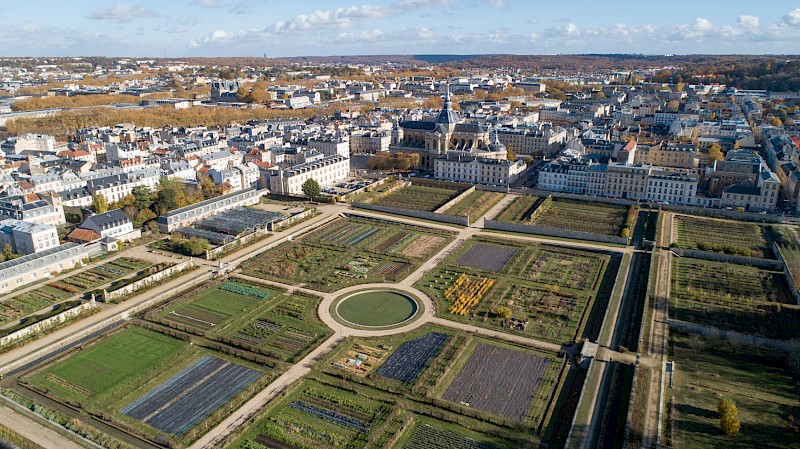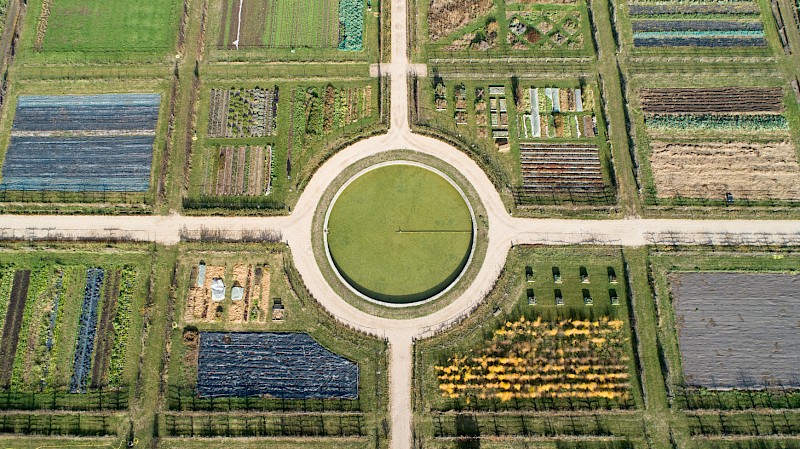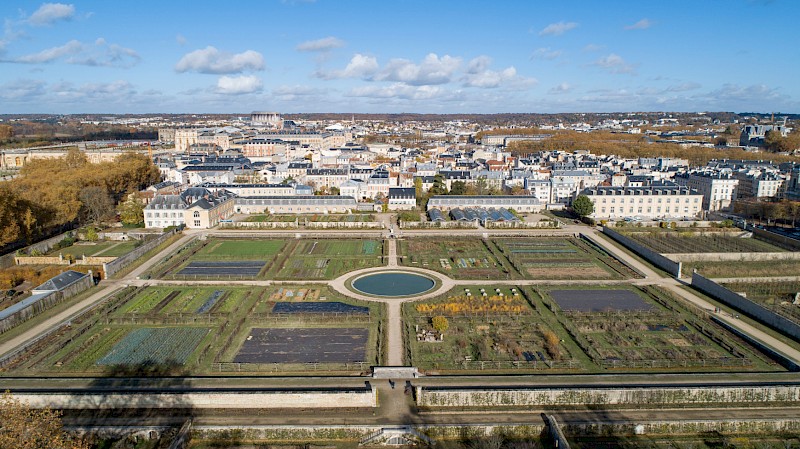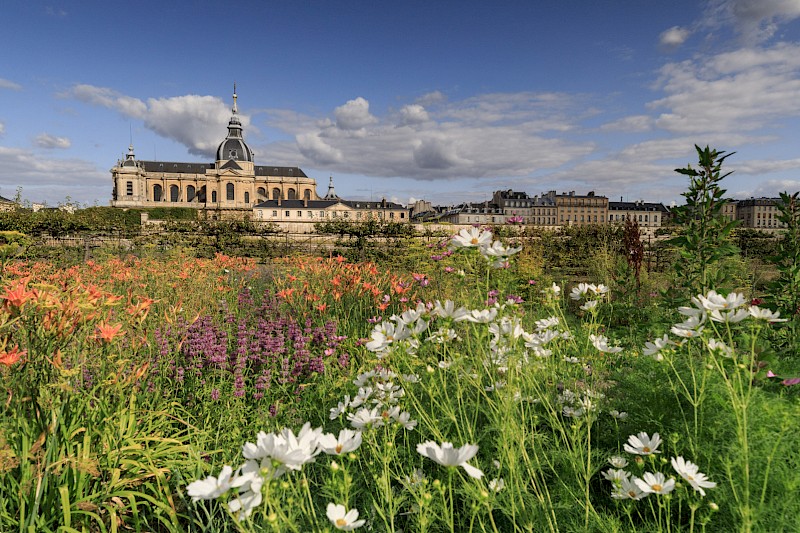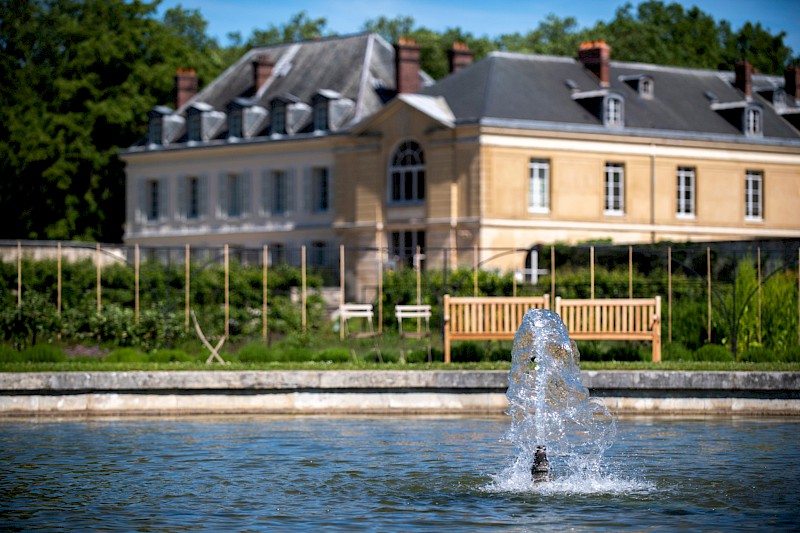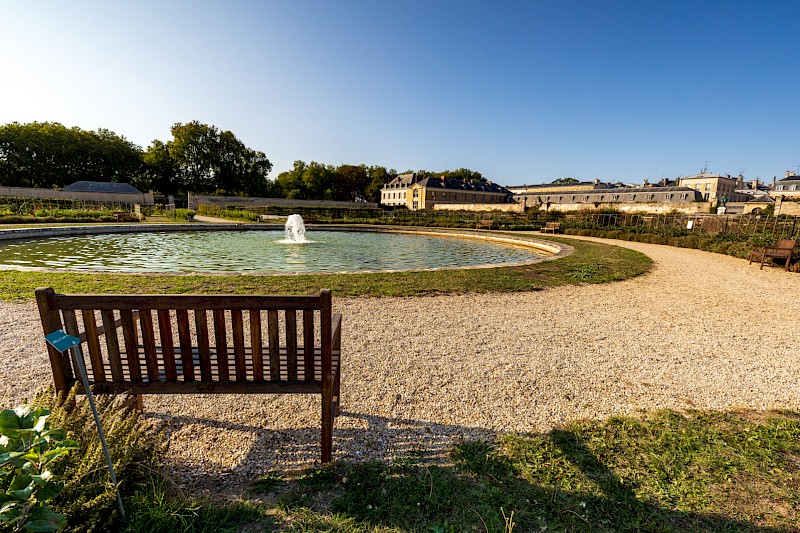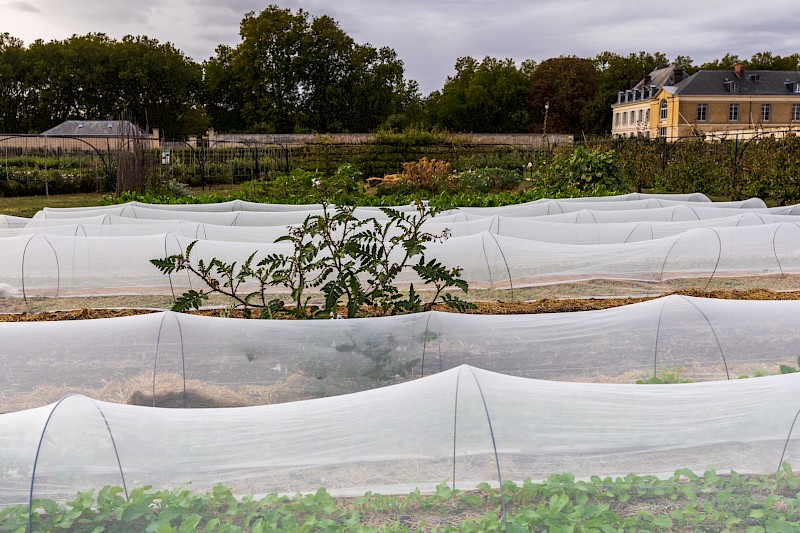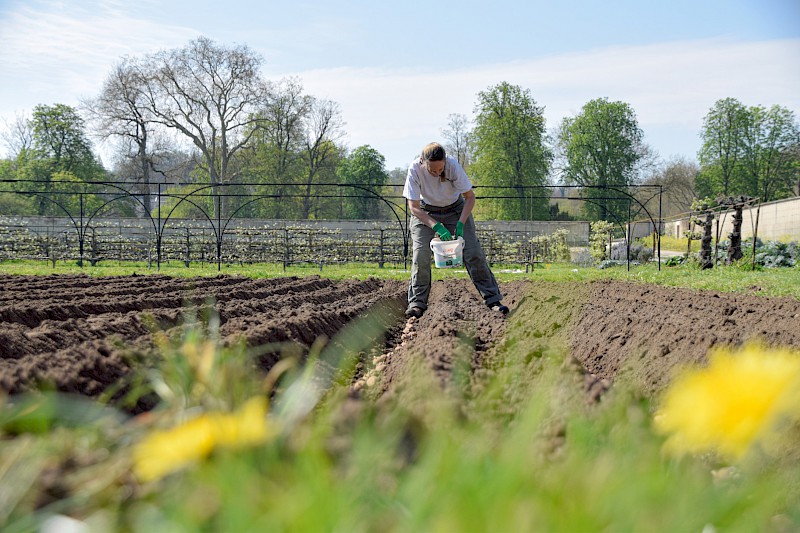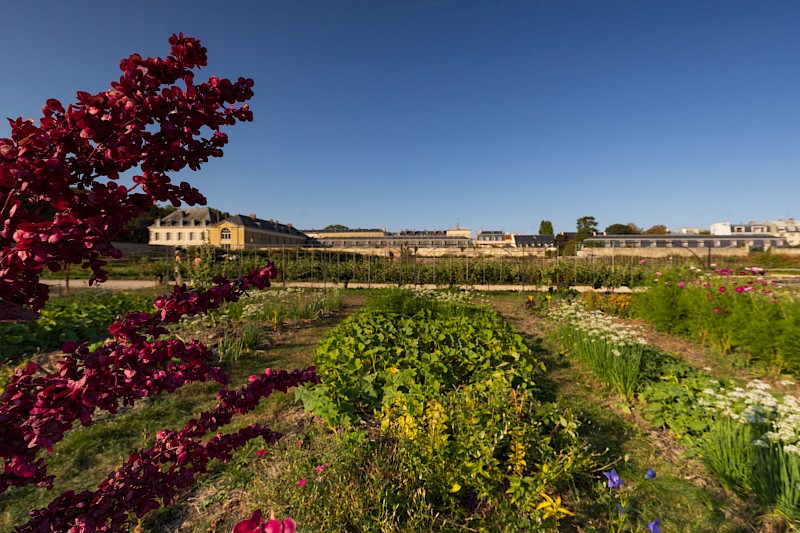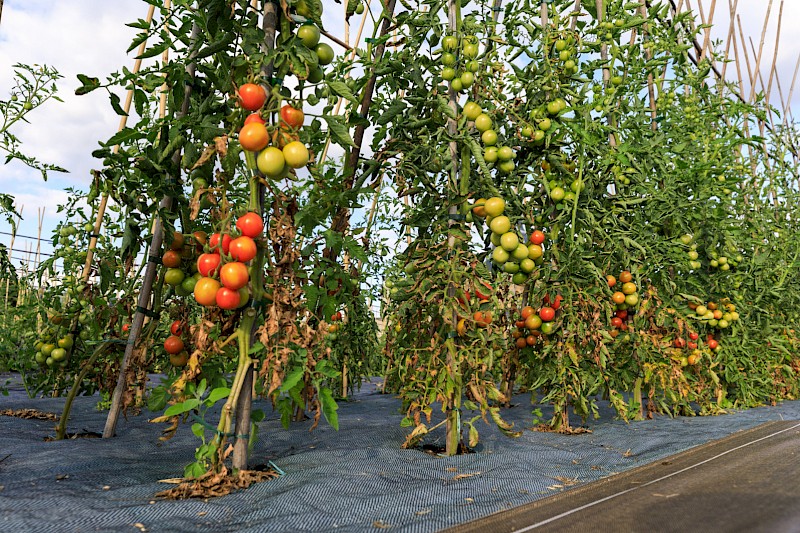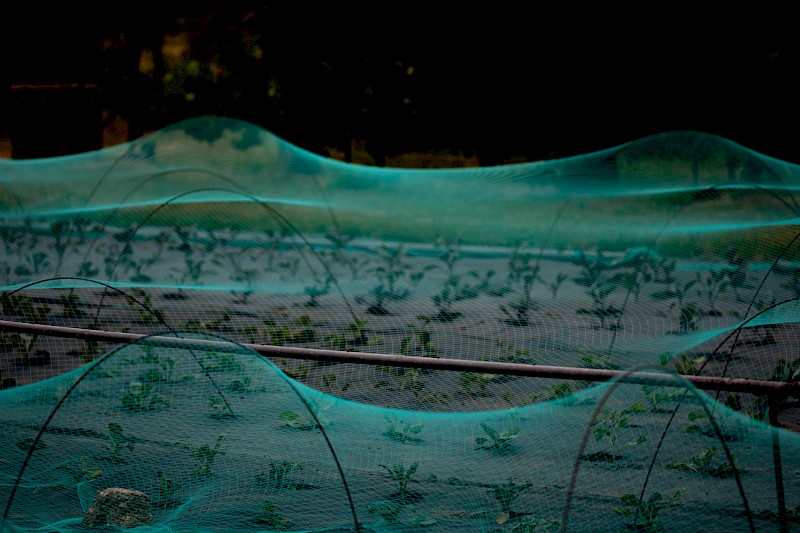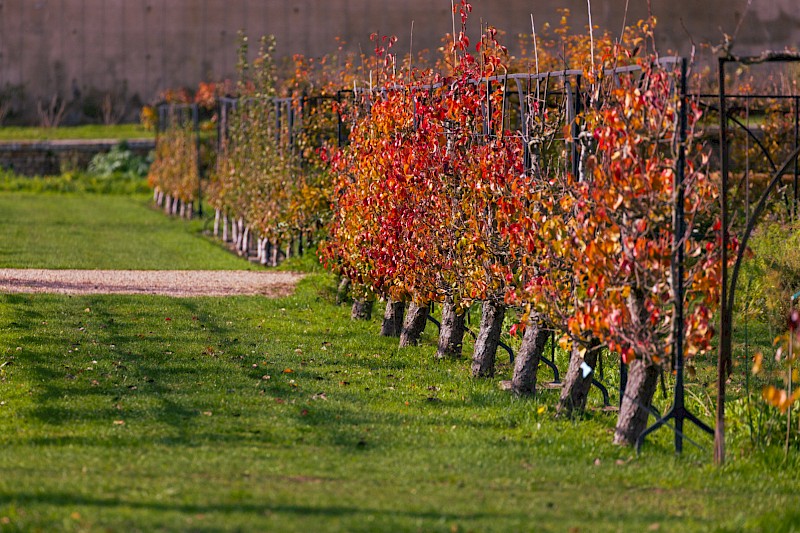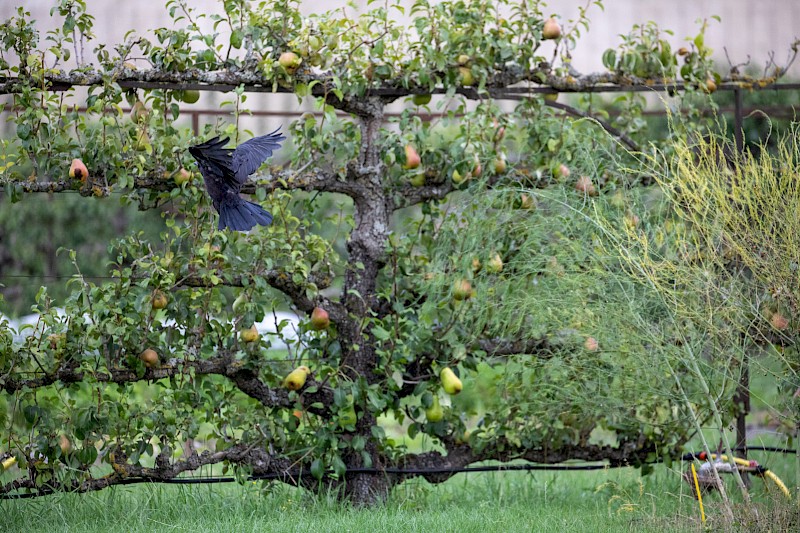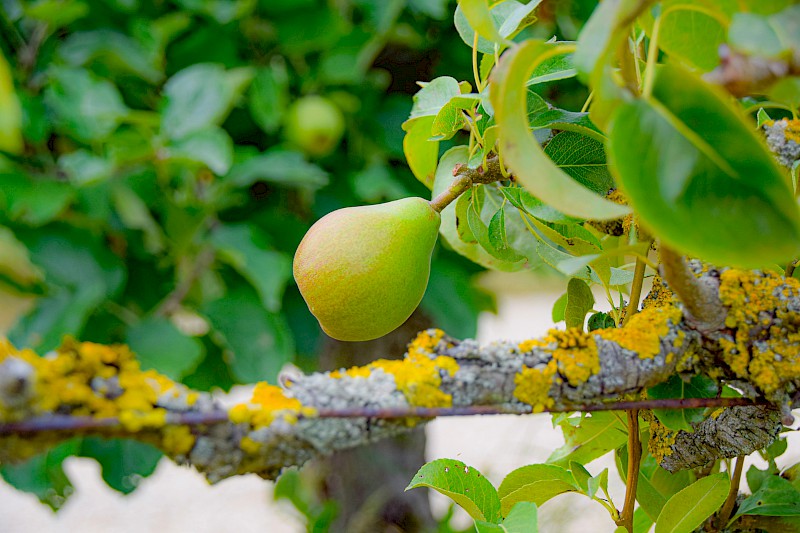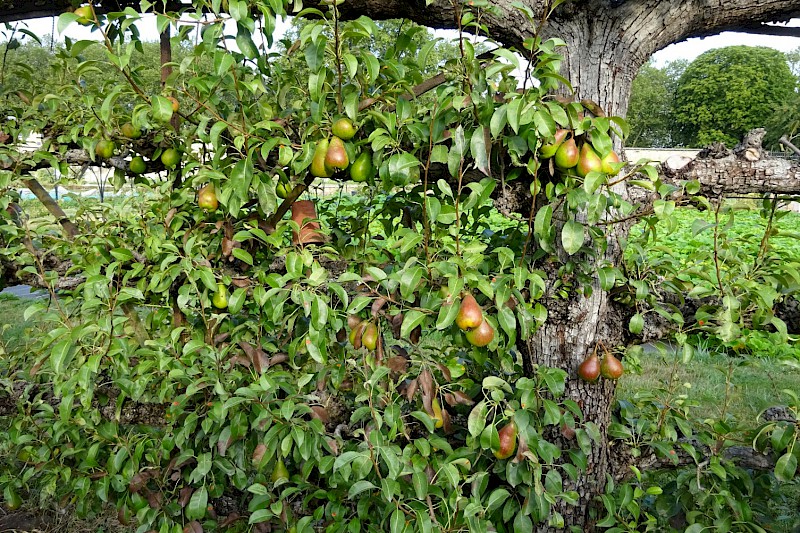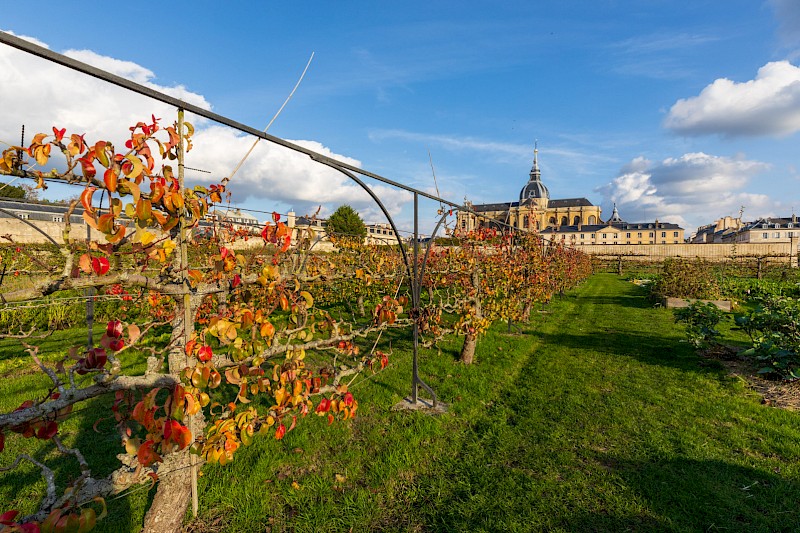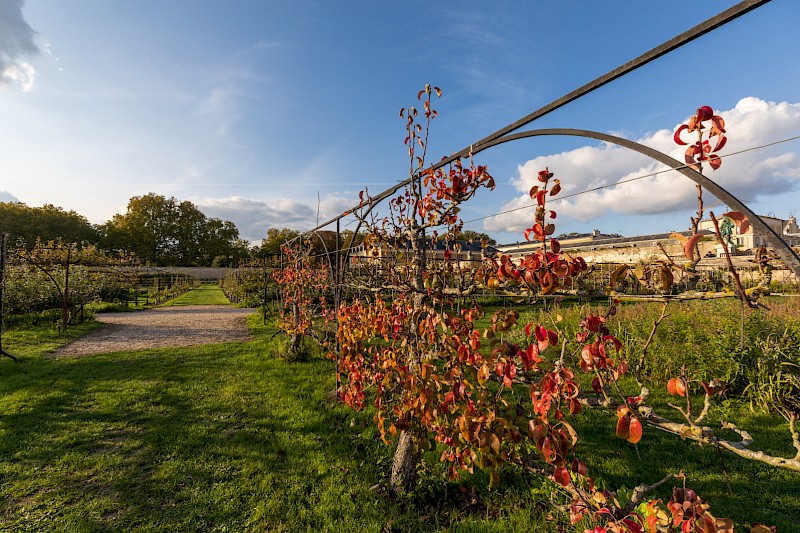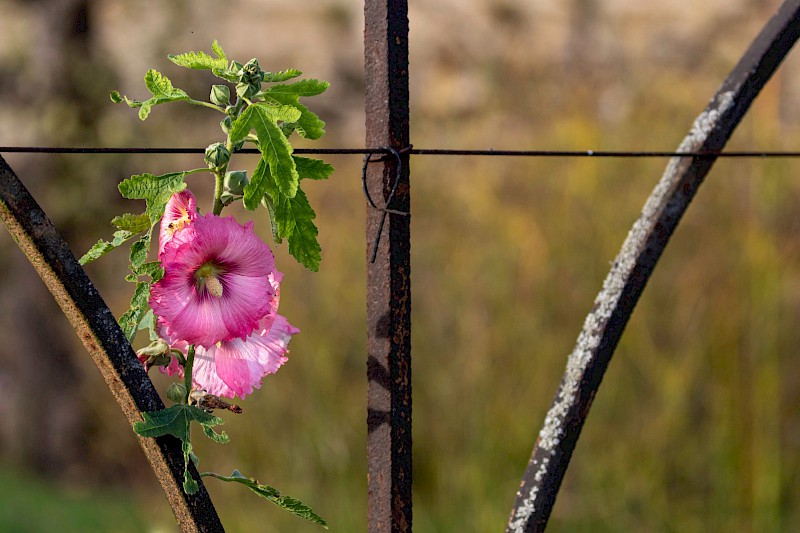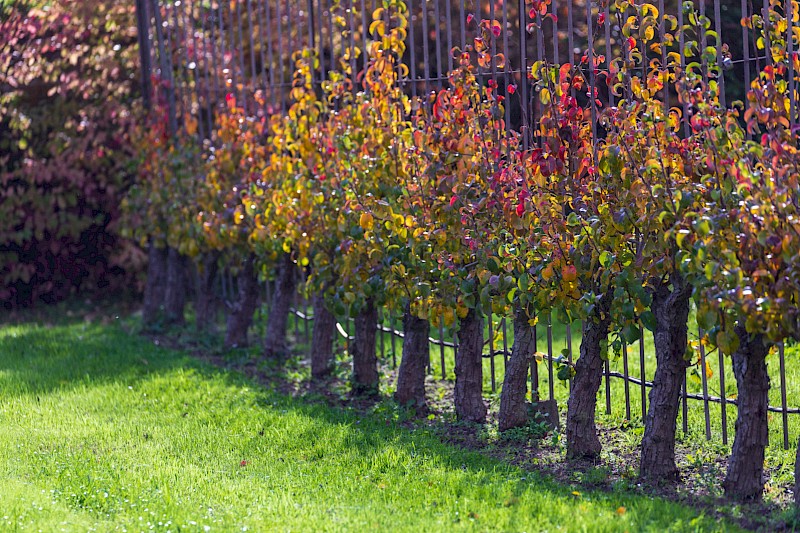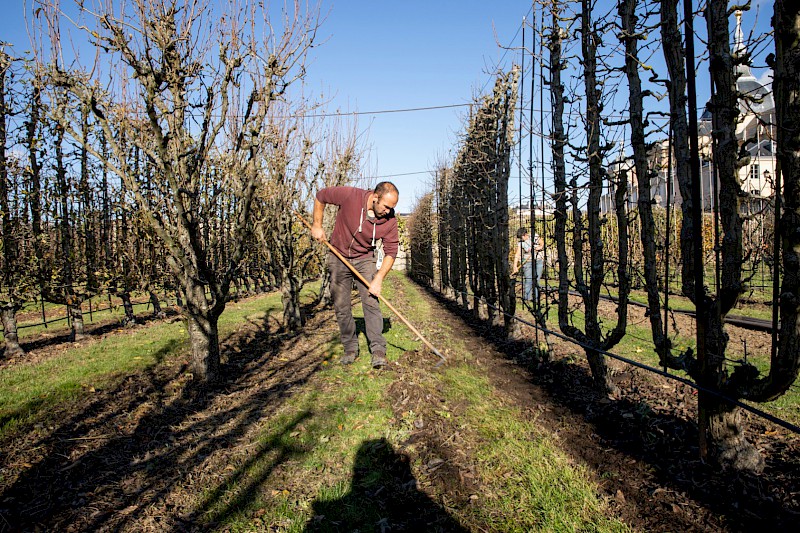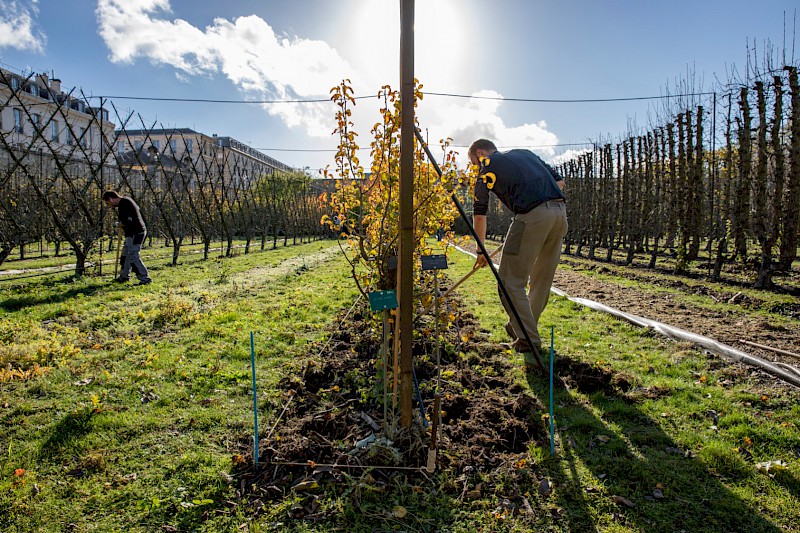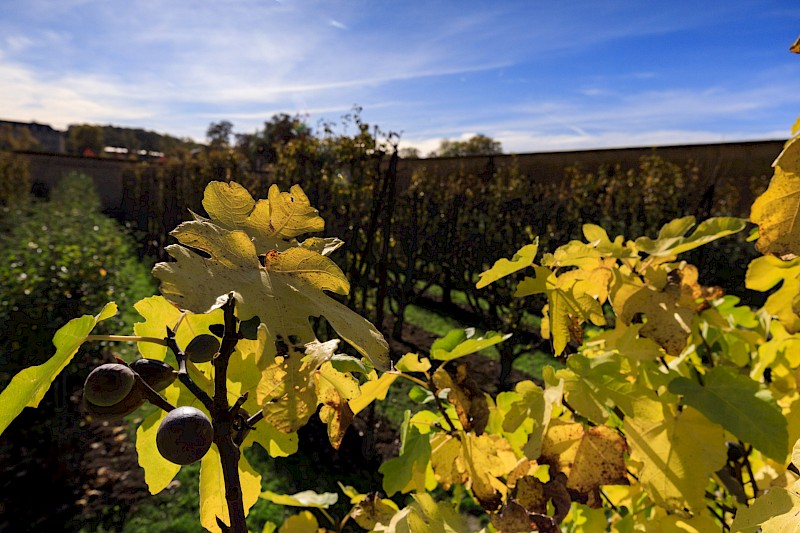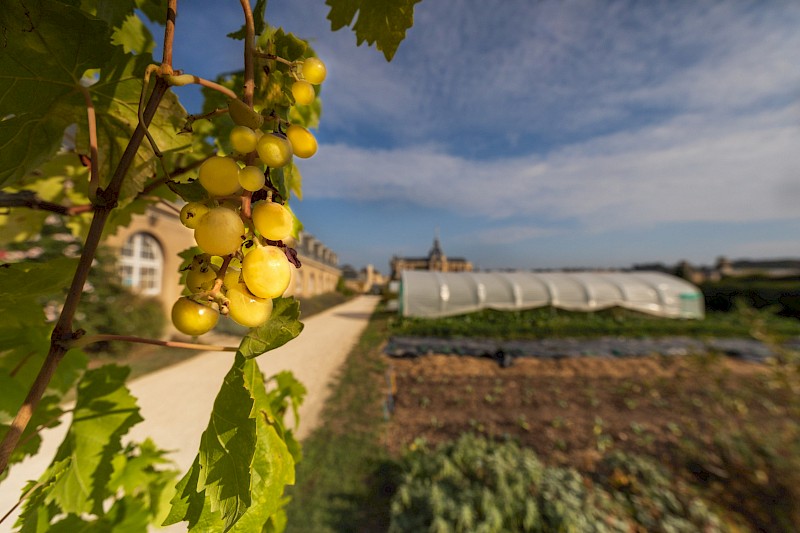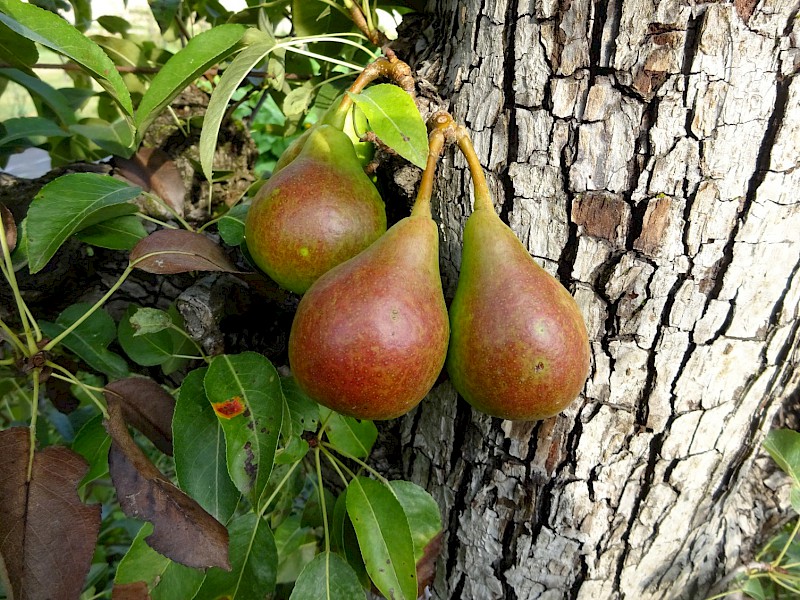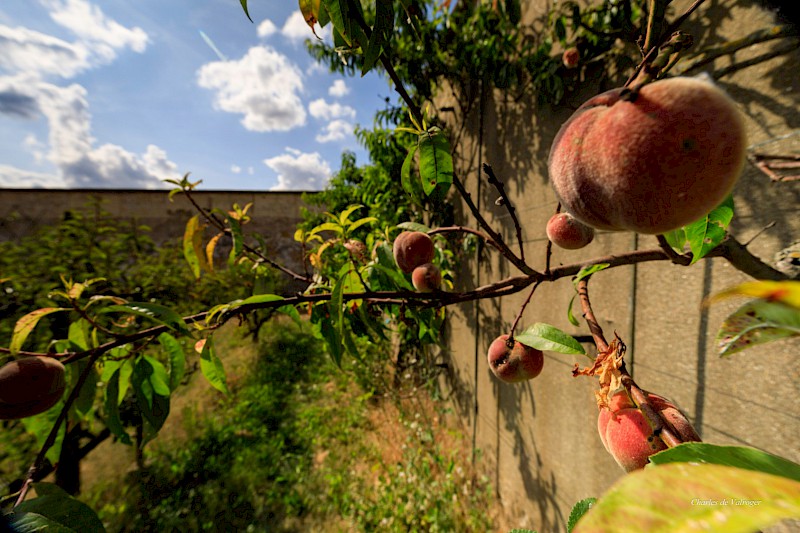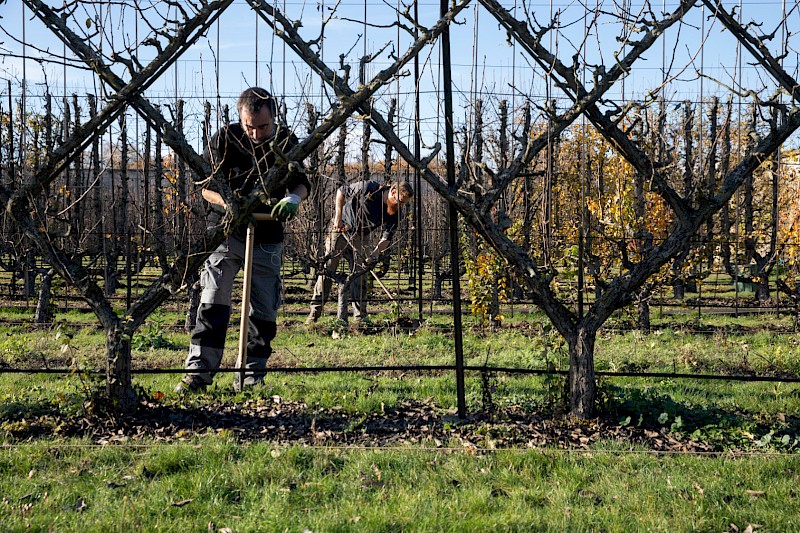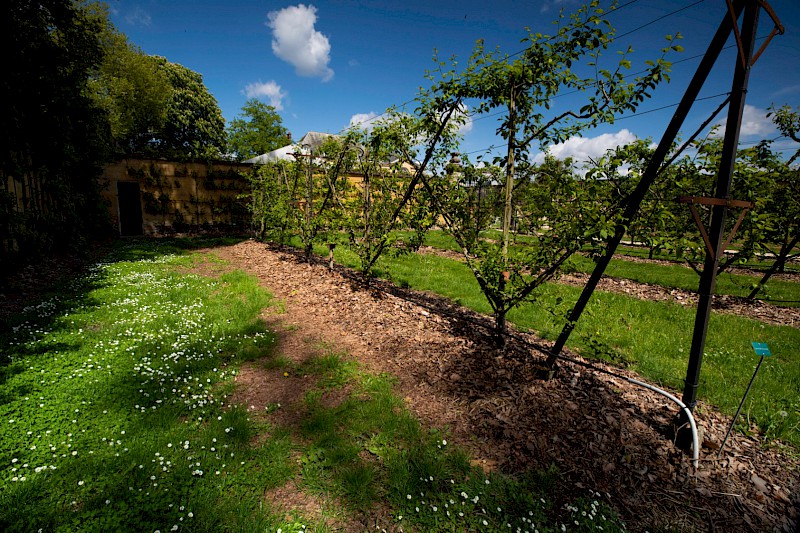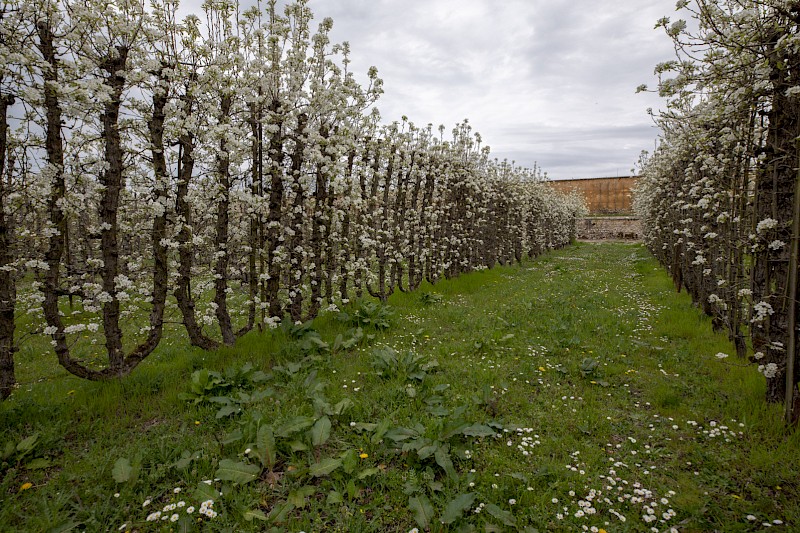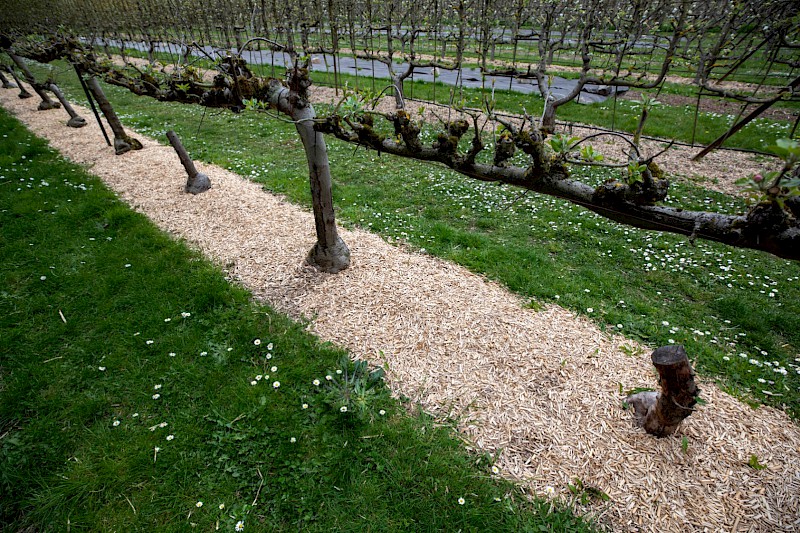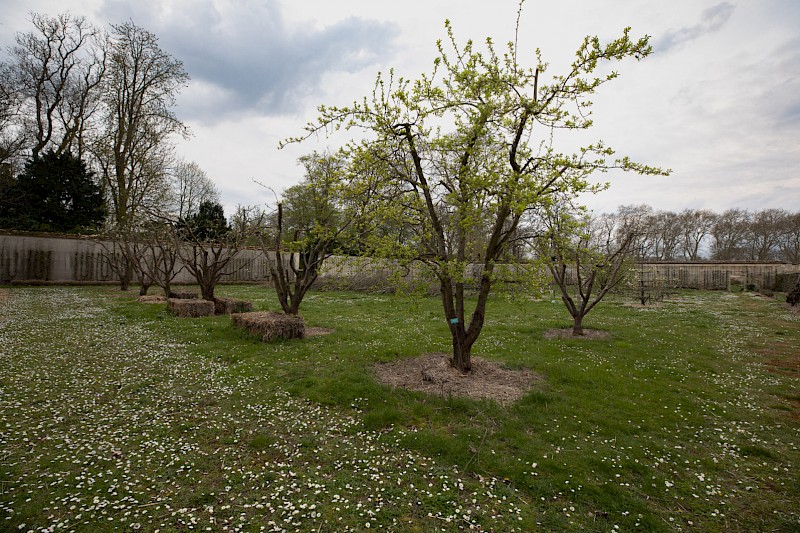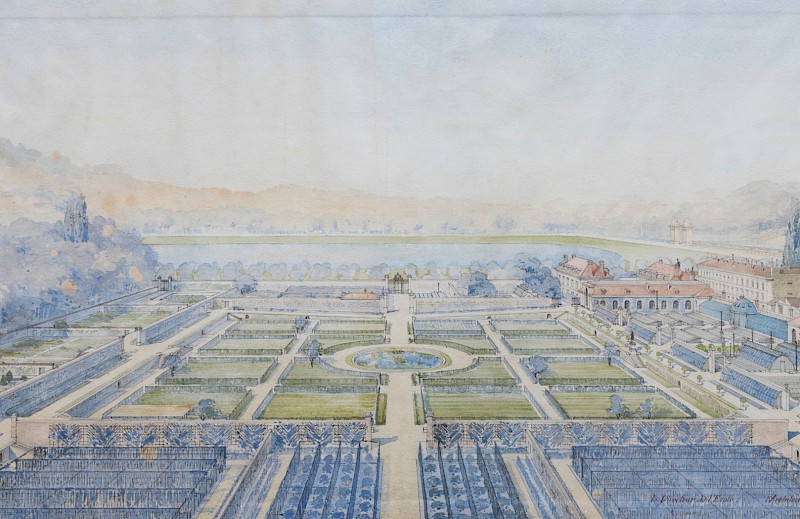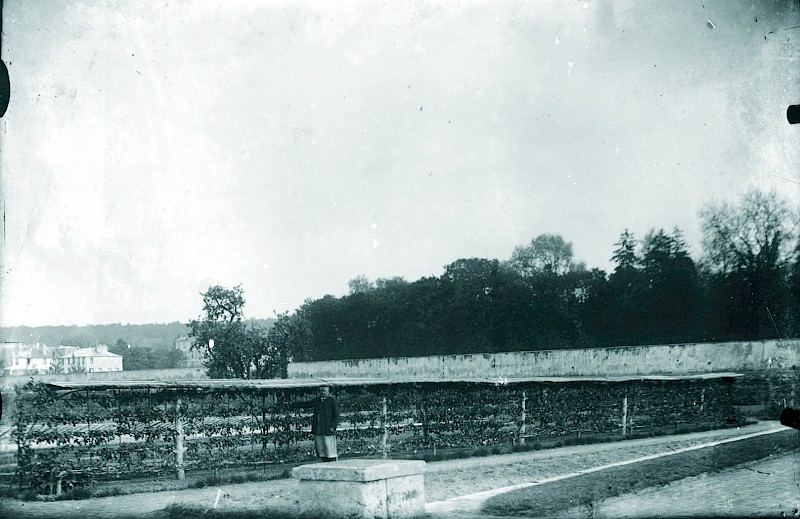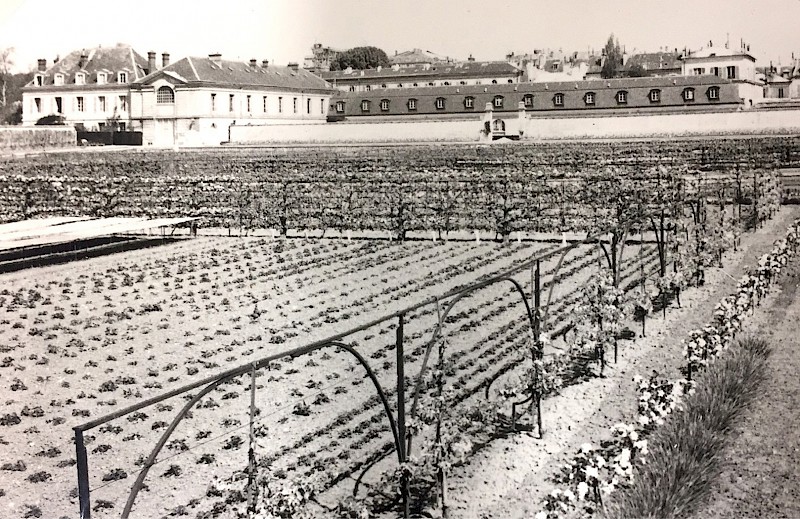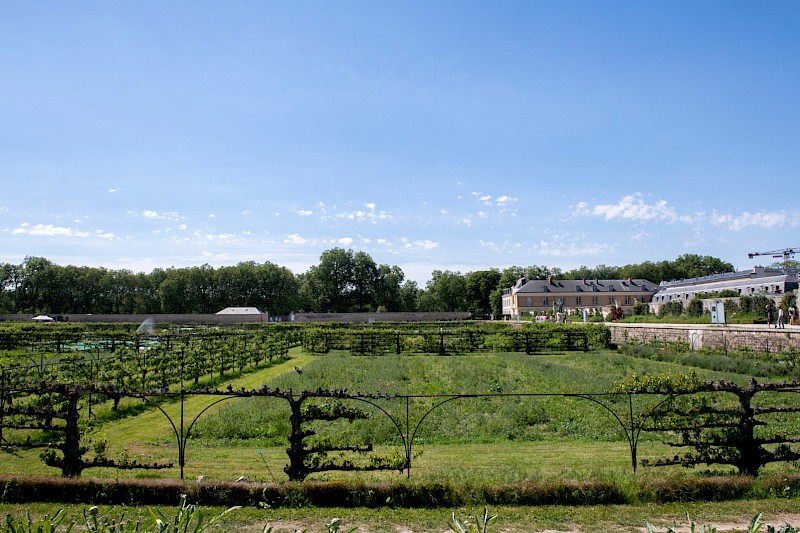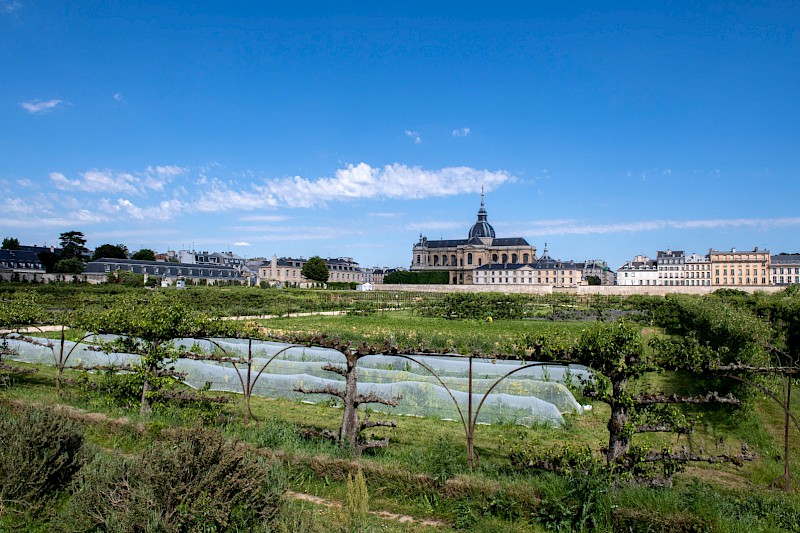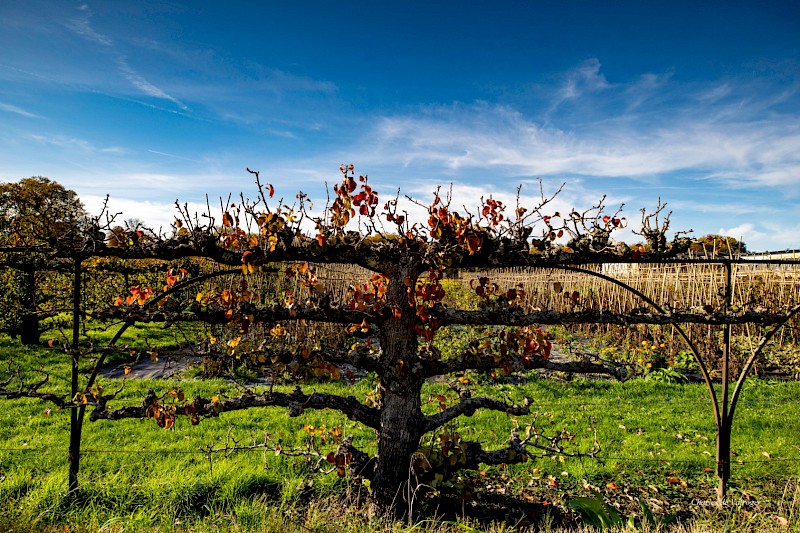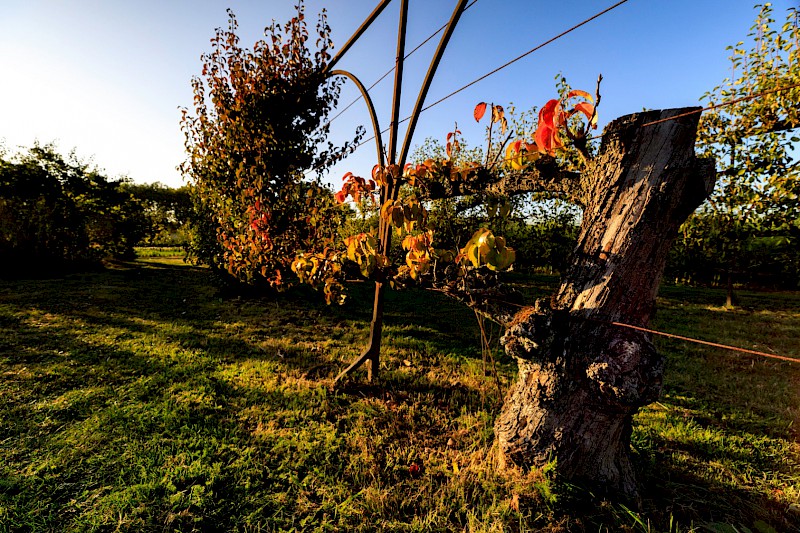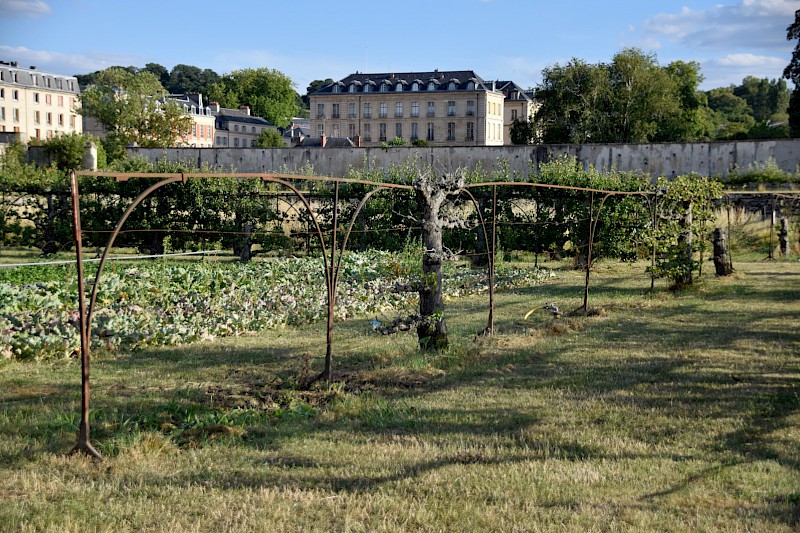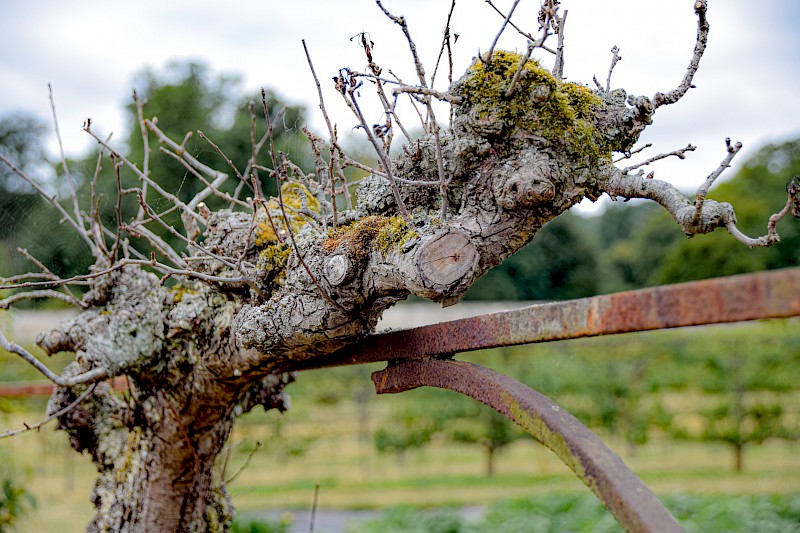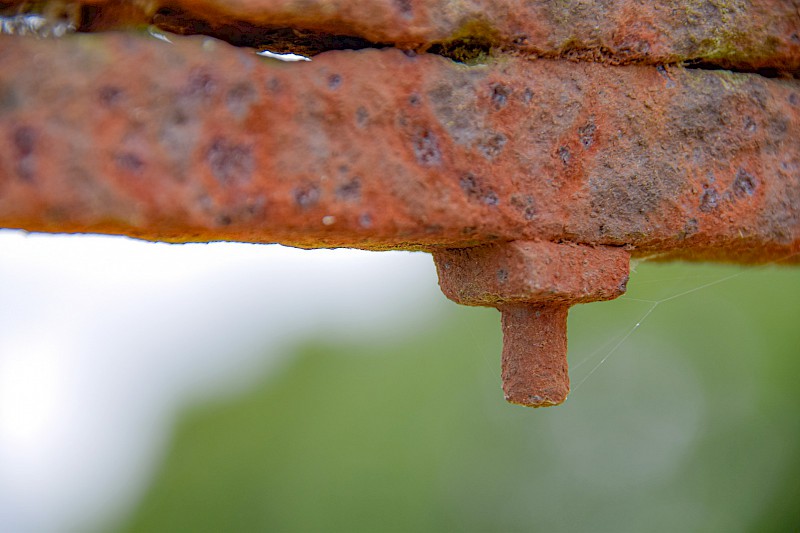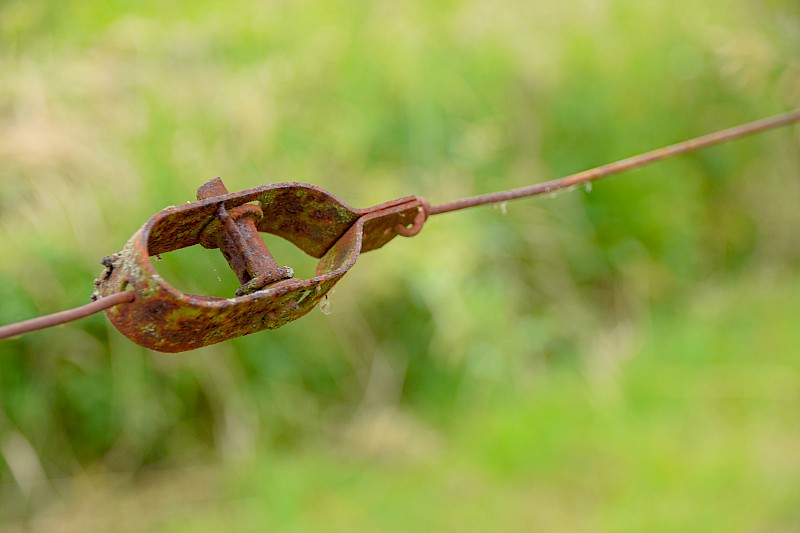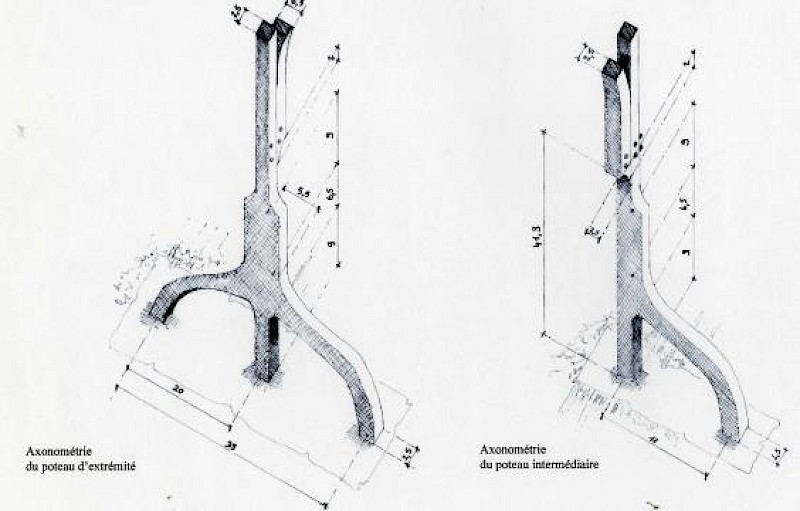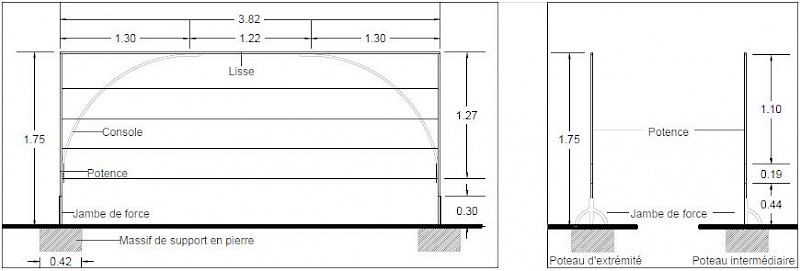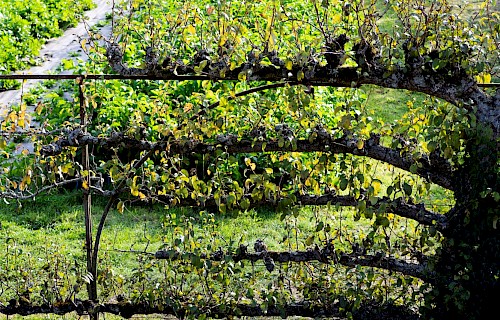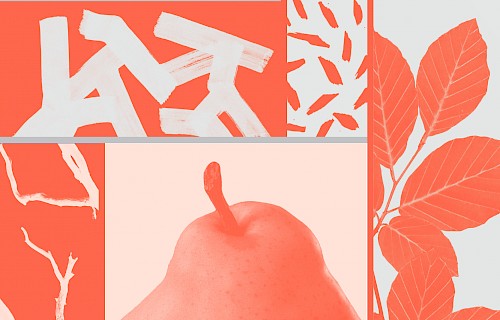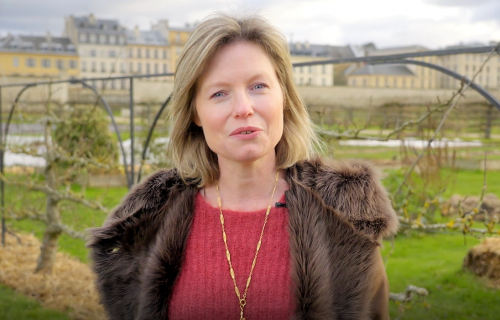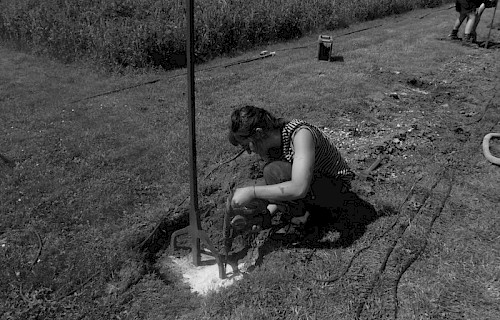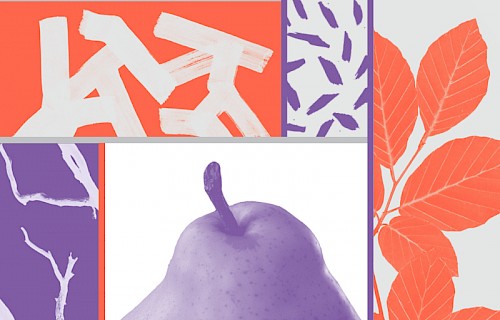the restoration project
The replanting of the Grand Carré in the state that it probably was at the end of the 18th and beginning of the 19th century is an integral part of the overall program for the heritage conservation and development of Potager du Roi.
The Grand Carré
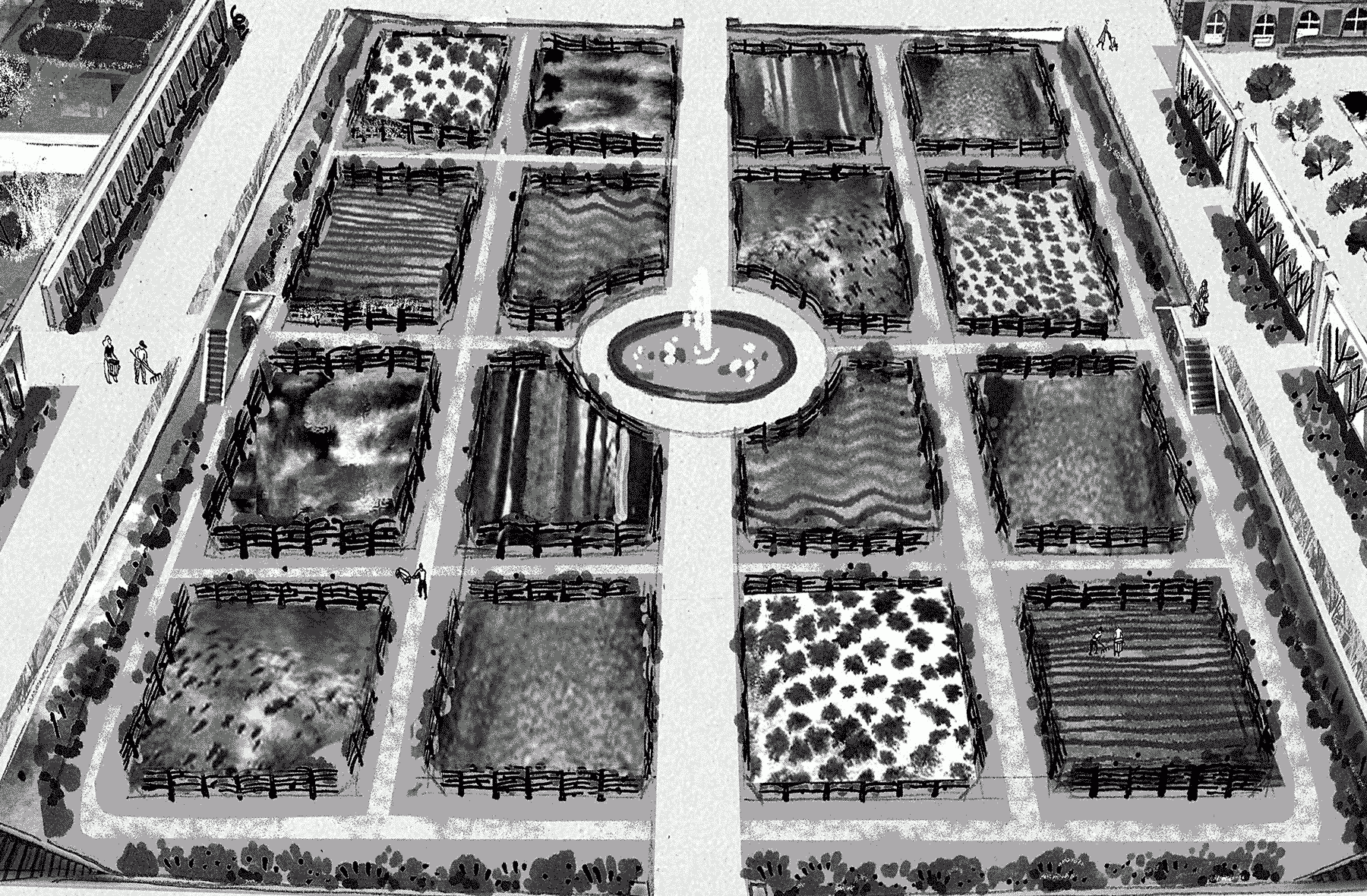
At the heart of the garden: the Grand Carré
Open to the sky, crossed by straight lines, the Grand Carré is an accomplished example of the French garden in the Baroque age. Since the creation of the garden and still today, you have to pass at least two large walls before you can have access to this central heart. In addition, in the 17th and 18th centuries, the final access had to be via a downward staircase. At the end of the 18th century, the Sunrise (Levant) and Sunset (Couchant) terraces were transformed into ramps to facilitate the circulation of horse drawn carts. It is a protected place and, at the same time, the main stage of the site.
The central basin
When the garden was built, the central basin was double its current size. It served as a reservoir for irrigating the entire site. The water was supplied by the so-called "Etangs de Gobert" reservoirs at the high east end of Rue d'Anjou. It was halved in size at the end of the 18th century. The Grand Carré has not lost the freshness and music of its fountain and has pleasantly gained in surface area for production!
The 16 market garden plots
Covering an area of 3 hectares (over 7 acres), the Grand Carré is divided into 16 plots of vegetable crops. Each plot is surrounded by pear trees trellised on wrought iron frames. Some plots have an additional row of apple trees trained as simple cordons. The size of the cultivated space inside each plot is the equivalent of a quarter of an arpent of Paris (an arpent is a pre-metric system of measure). If one adds together the 4 plots (without the wide exterior alleys) that make up a district or one quarter of the Grand Carré, you have an arpent (3,419 m²), that is to say the typical surface area of an 18th century Parisian market garden. In order to respect crop rotation, annual vegetables do not have permanent spaces in the Grand Carré. Some spaces are relatively stable either because they are cultivated with semi-permanent or perennial plants such as the asparagus bed or the medicinal and herb plot or because they are devoted to a group such as the landscape student and continuing education plots.
The pear trees
In the 17th century, the pear is the French fruit par excellence. It is the fruit of which every gentleman should know a number of varieties, starting with the ‘Bon Chrétien dHiver’, ‘Rousselet ’and surely ‘Bezi de la Motte’, Louis XIV’s favorite pear. Jean-Baptiste de La Quintinie says he has tasted more than 300 varieties but declares that there are only about fifty good ones. Today, in the Grand Carré, one can find the 'Duchesse d'Angoulême' with its quince aroma, its lemony taste and its bumpy and almost square shape; the 'Louise bonne d'Avranches', a rather small, dark green pear with a beautiful brilliant red that develops on the sunny side, and, above all, with its sweet flesh and floral aroma. These two varieties are from the first half of the 19th century. From the middle of the 19th century one can also find 'Passe crassane', a (some may say “the”) winter pear that can be kept quite easily until March.
The metal trellising frames
When the garden was created, the 16 plots or squares of the Grand Carré were surrounded with pear trees that La Quintinie described as bushes. Today we would probably call them goblets. The introduction in the Grand Carré of contre-espaliers pear trees, that is pear trees trellised on a support structure separate from a wall, dates from the end of the 18th century. It was a renowned architect, Louis-François Trouard, who made this change. He did not yet use the same metal structures as today, as some parts were made of wood. The current wrought iron structures date from the second half of the 19th century. Trained branch after branch and tree after tree, the five parallel levels of horizontal lines of the Palmette Legendre shaped pear trees, are a real tour de force by the gardeners of Potager du Roi. They are a demonstration of gardening know-how, of diligence and meticulous work.
Historic trees
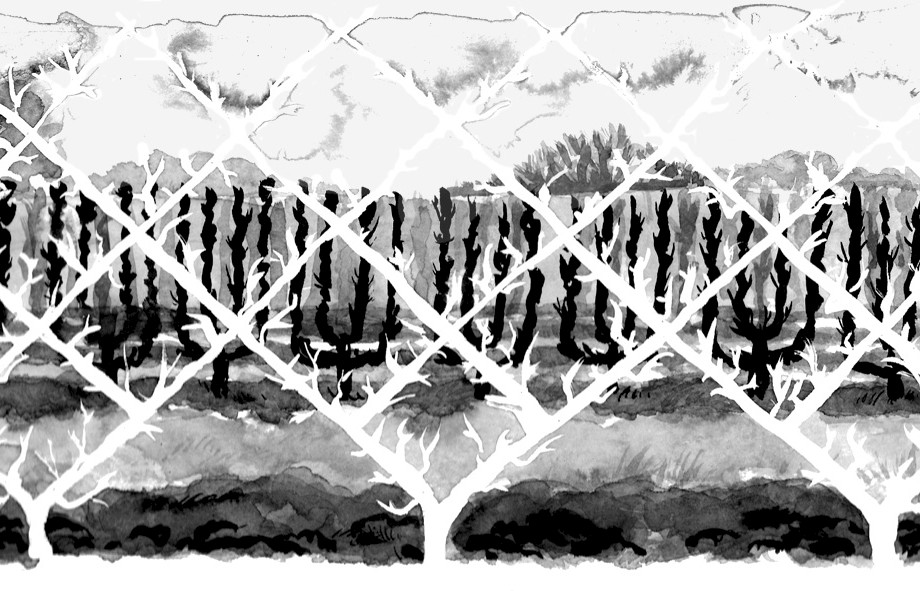
How many trees in Potager du Roi?
3,768 fruit trees are cultivated at Potager du Roi (at the moment of writing). One must add the shrubs and other woody, edible or ornamental, plants. This number is one and a half to two times more than at the time of La Quintinie. It is also much lower than the number of fruit trees at the turn of the 20th century. In 1910, there were approximately 14,500 fruit trees. The history of the trees in the garden is not a linear one. During the very cold 1709-1710 winter, half of the trees were lost and during the very early below freezing temperatures of the 1879-1880 winter it is estimated that 80 % of the fruit trees died. The main difficulty today is the natural aging. The oldest trees on the site were planted in the 1880s and are now 140 years old. This is exceptional for espalier trees planted for production. In the early 20th century, Jules Nanot, professor of fruit tree culture and director of the National School of Horticulture, writes that the lifespan of a pear tree at Potager du Roi was 70 years (compared to 300 to 350 years if left to grow by itself). A program to renew the historic trees of Potager du Roi is being deployed by replanting new subjects wherever possible.
How many fruit varieties?
The available sources do not give exact numbers, but it is estimated that in the 17th century Potager du Roi was dominated by pear, peach and fig trees. Jean-Baptiste de La Quintinie proposed the cultivation of approximately 70 varieties of pears and only 7 varieties of apples. At the end of the 20th century, the garden had 32 varieties of pears and 39 of apples, compared to 309 and 565 respectively at its beginning. Today, pears, with 140 varieties, and apples, with 160 varieties, remain dominant and are found alongside other species and their varieties. There is a growing number of apricots, cherries, figs, peaches, plums, as well as fruiting shrubs such as arbutus, blackcurrant, raspberry, currant or even hazelnut.
Potager du Roi fruit tree shapes
Palmettes Legendre and Verrier, vertical double U, tricroisillons, fans and step-overs (or cordons, simple or double or more)… there are more than 50 fruit tree shapes at Potager du Roi. These have both an aesthetic and a practical function. On the one hand, with more individual attention, the fruits become larger and more colourful being more exposed to sunlight and, on the other hand, the trees, especially those in espalier, counter-espalier and cordon, take up less space and can be planted more densely. Jean-Baptiste de La Quintinie did not give more specific names to his fruit tree shapes beyond “espalier” and “bush”. Moreover, he specifically states that he did not want any contre-espalier at Potager du Roi (a contre-espalier is an espalier without a wall behind it to grow on). The real explosion in the number of fruit tree shapes is a phenomenon dating mainly from the middle of the 19th century. The complex shapes, often essentially ornamental and fanciful, require the selection of suitable varieties and rootstocks as well as an abundant labour force and the regular use of spraying or other treatments. The “à la diable” tree shapes, fan shapes, standard or free standing as well as diversified hedges, which are all of historical interest while also being economical in terms of resources and adapted to the changing climate context, are being reintroduced or their presence expanded. There are few experts in historical fruit tree pruning methods, such that the skills and know how maintained at Potager du Roi is all the more precious.
State of conservation
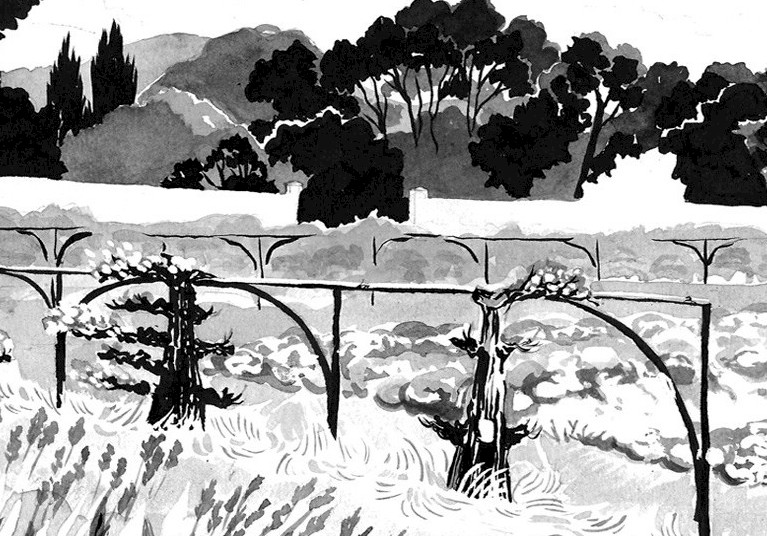
A bit of history
Louis XIVth liked to come and admire his kitchen garden. He would arrive by the King's Gate and then go up the ramp planted with sixteen 'Robine' pear trees, before discovering the Grand Carré. The appearance of the Grand Carré changed a century later. The first trellising structures were installed at the end of the 18th and the beginning of the 19th century. It is at that time that was created the spatial and visual organization that has become so emblematic today. The vertically trained gobelet shaped pear trees were replaced by more horizontally trained counter-espalier pear trees. Counter-espalier trellising - the branches are guided along wires stretched between stakes - allows the tree to benefit from optimal exposure from all sides angles. In his Traité des arbres fruitiers, Treatise on Fruit Trees (1768), Henri-Louis Duhamel du Monceau wrote: « les arbres en éventails, en contre-espaliers, en palissades, embarrassent moins les jardins (que les arbres buissons), sont d’un produit à peu près égal et sont un ornement plus agréable à la vue » ("trees trained as fans, contre-espaliers and pallisades encumber gardens less (than gobelets or bushes), produce more or less as much and are of greater pleasure for the eye"). An archival source of 1773 that prepares for the introduction of counter-espalier in Potager du Roi explains : « les treillages des contre-espaliers […] en fer coutent à la vérité davantage mais leur durée éternelle doit les faire préférer » ("the iron trellises of the counter-espaliers [...] in truth do cost more, but their eternal duration must make them preferable").
In what condition are the trees
The winter of 1879-1880 is early: temperatures drop below 0 ° C in mid-November and do not rise for over a month. The trees are not yet hardened enough to survive this onslaught of ice and more than three-quarters die. A massive replantation is necessary and occurs at the end of the 19th century and in the beginning of the 20th century. Today many of the trees have far exceeded their normal productive life expectancy. Jules Nanot, professor of fruit tree culture and director of the National School of Horticulture at the beginning of the 20th century, estimates that the lifespan of a pear tree in Potager du Roi is 70 years. As part of the conservation project, replanting is planned with species, varieties and fruit tree shapes that do not all have a similar growth rate and life expectancy. It is thereby possible to reduce the overall impact on crop production and management. while preserving the structured aesthetics of the site.
State of the iron trellis structures
Pear trees are incredibly vigorous and strong! Wrought iron frames and strong wire are essential to creating the Palmette Legendre fruit tree shape. After 140 years, with the constant application of force by the pear trees and the effects of air, water and changing temperatures, the iron erodes and the welds fail. All of the existing trellis frames are far too fragile to allow replanting without restoration or renovation or replacement of certain parts. The junction points at the top and bottom of the arched brackets are among the most fragile sections. A certain number of the stone foundations for the principal vertical posts are also in poor condition and contribute to the general instability of the entire structure.
Restoration stages
➊
Restoring the frames
The work concerns conservation, restoration and renewal. One must first dismantle and remove the structure. In a workshop, the rust must be eliminated, the bent parts straightened, the junctions overhauled. Then comes sanding, metallizing and rust-proofing. Renewal of missing pieces is done with hand forged wrought iron. These can be the frame post, the strut, the horizontal rail or the arched brackets. The structure is then brought back to the garden and put back together. It is a key moment as the level must be the same from one side of the garden to the other. During the absence of the structures, the gardeners have cultivated cover crops to re-invigorate the soil. After the trellises have been installed, the gardeners add the wire and the pieces of wood, which will be used to guide the soon to be newly planted tree branches.
➋
Choosing the varieties
The geographical distribution of different types of pears within the Grand Carré by La Quintinie at the end of the 17th century guides the varietal choices of today. Summer pears are planted around the 4 garden plots of the northwest quarter of the Grand Carré; autumn pears around the 4 garden plots of the southwest quarter and pears. Winter pears are planted around the 8 garden plots of the eastern half of the Grand Carré. To ensure the good pollination of all the pears of Potager du Roi, an exception is made to this distribution: the 16 lines of pear trees which border the central gravel paths will be planted with the summer pear variety 'Williams bon chrétien'. The pollen of this late 18th century variety is particularly appreciated by other pear trees but the variety is best known for its particularly aromatic fruit. In the United States it is known as the ‘Bartlet’ pear.
➌
Replanting
The gardeners have organized the replanting program for each line of pear trees in three phases: the removal of old trees, the regeneration of the soil over several months and the actual replanting of new trees during winter months. It is the emblematic fruit tree shape – Palmette Legendre – which will be reproduced. One needs ten years for the pear trees to reach the five levels of this difficult to produce shape. Even with the specialized know-how of the gardeners, it takes approximately twenty years for the tree to reach its adult or mature size.
Replanting a line of pear trees
